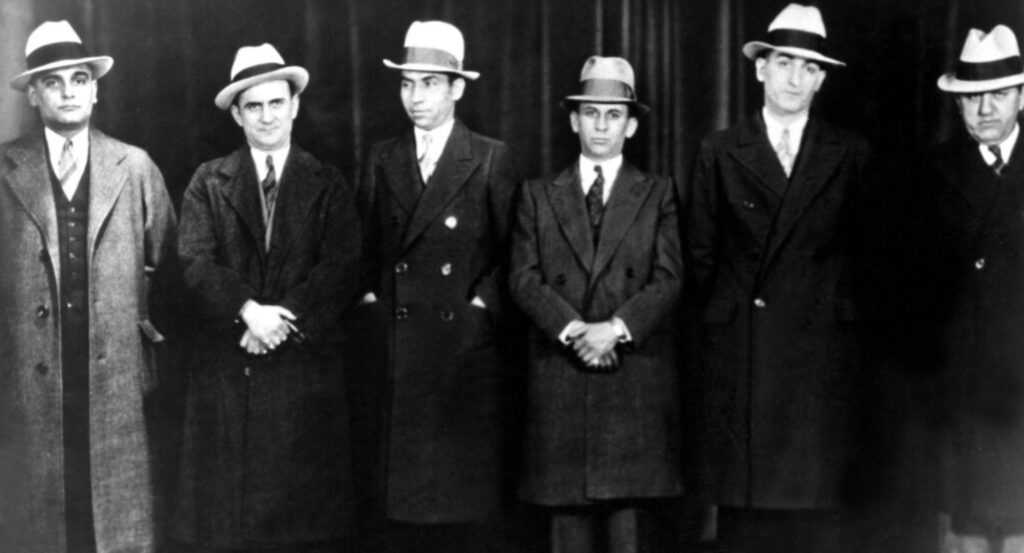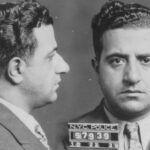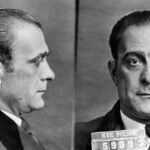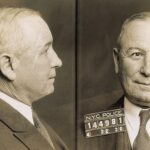The Castellammarese War, a brutal conflict that unfolded between 1930 and 1931, serves as a cornerstone in the history of organized crime in the United States. This war, fought primarily between two powerful factions within the Italian-American Mafia, led by Joe Masseria and Salvatore Maranzano, had far-reaching implications. It not only redefined the power dynamics within the Mafia but also set the stage for the modern organized crime syndicates that we recognize today.
The Backdrop – A City Ripe for Conflict
New York City during the Roaring Twenties and the early 1930s was a metropolis teeming with opportunity and danger in equal measure. The city was a melting pot of cultures, a place where immigrants from all corners of the globe congregated in search of the American Dream. Yet, beneath the glitz and glamour of Broadway and Wall Street, a darker, more sinister economy thrived. Organized crime syndicates, representing various ethnic groups, carved out their territories and operated their illicit businesses with a level of sophistication that often mirrored legitimate enterprises.
The Irish Mob, for instance, had a stronghold in Hell’s Kitchen and controlled various rackets, including loan sharking and illegal gambling. Jewish gangsters like Meyer Lansky and Bugsy Siegel were making names for themselves, particularly in the realms of bootlegging and casino operations. Yet, it was the Italian Mafia, with its roots tracing back to the secret societies of Sicily, that would eventually overshadow these groups and establish a criminal empire of unprecedented scale and influence.
The Castellammarese War, named after the Sicilian town of Castellammare del Golfo, birthplace of Salvatore Maranzano, was the catalyst for this transformation. This war was not an isolated event but rather the culmination of years of tension, rivalry, and territorial disputes among various Italian-American crime families. The Prohibition era, with its lucrative opportunities for bootlegging, had intensified these rivalries, making the stakes higher than ever. The Castellammarese War would become the defining conflict that would set the rules, hierarchies, and territories for the Italian Mafia for decades to come.
The Key Players – Masseria and Maranzano
In the annals of American organized crime, few figures loom as large as Joe Masseria and Salvatore Maranzano. Joe “The Boss” Masseria was not just another mobster; he was a criminal mastermind who had climbed the ranks through sheer grit, cunning, and an unquenchable thirst for power. Born in Menfi, Sicily, Masseria immigrated to the United States in the early 1900s and quickly immersed himself in the criminal activities that Italian immigrant communities were often forced into due to social and economic marginalization. By the late 1920s, Masseria had consolidated power and was leading one of the most influential crime families in New York. His operations spanned various criminal enterprises, from extortion to the narcotics trade, and his influence reached far beyond the five boroughs of New York City.
Salvatore Maranzano, on the other hand, was a man of a different ilk. Born in Castellammare del Golfo, Sicily, Maranzano was a classically educated man who had studied to become a priest before ultimately choosing a life of crime. Unlike Masseria, who was more pragmatic and willing to adapt to the American way of doing things, Maranzano was a traditionalist at heart. He was deeply influenced by the hierarchical structures of the Sicilian Mafia and believed that the American Mafia needed a similar level of organization to thrive. Maranzano envisioned a Mafia that operated like a Roman legion, with a strict chain of command and a set of codes that governed the behavior of its members.
The contrasting philosophies and leadership styles of these two men were representative of a broader ideological divide within the Italian-American criminal underworld. Masseria’s faction, often referred to as the “Joe the Boss” gang, was more cosmopolitan and included mobsters from various regions of Italy. Maranzano’s crew, by contrast, was predominantly Sicilian and operated more like a traditional secret society, complete with initiation rites and a strict code of conduct. This ideological divide set the stage for a conflict that was as much about the future direction of the Italian Mafia as it was about control of lucrative criminal rackets.
The rivalry between Masseria and Maranzano wasn’t just a two-man show; it involved a complex web of alliances, betrayals, and strategic partnerships with other criminal organizations. Masseria had allies among the Irish Mob and even some Jewish gangsters, while Maranzano sought to build a coalition of strictly Italian or Sicilian mobsters. This network of alliances and rivalries added another layer of complexity to the Castellammarese War, making it a multi-dimensional conflict that would reshape the American Mafia in ways that still reverberate today.
The Catalyst – A Struggle for Power
On a chilly February evening in 1930, Gaetano Reina met his untimely end, marking the ignition point of the Castellammarese War. Reina, a lesser-known yet influential figure in the criminal landscape, was an ally of Joe Masseria. His murder wasn’t just a random act of violence; it was a calculated move designed to send shockwaves through the underworld. The message was clear: no one was safe, and the struggle for power had officially commenced.
The murder of Reina was a strategic masterstroke, setting off a domino effect of violence, betrayal, and strategic maneuvering that would engulf the Italian-American Mafia for over a year. This was not a war fought in trenches or on open fields; it was waged in the backrooms of speakeasies, on the cobblestone streets of Little Italy, and in the luxurious apartments of mob bosses. The weapons of choice were not just guns and knives but also information, alliances, and the ever-present threat of betrayal.
The stakes in this war were astronomical. We’re not merely talking about a turf war; we’re discussing the control of multi-million-dollar criminal enterprises that spanned everything from bootlegging and illegal gambling to labor racketeering and extortion. The victor would not only gain control of these rackets but also establish the rules of engagement for the Mafia for years to come. The war was a high-stakes chess match, with each side making calculated moves to weaken the other. Assassinations were meticulously planned, often involving complex schemes and the involvement of double agents within rival factions.
The Role of Ethnicity and Alliances
The Italian Mafia of the early 20th century was a complex tapestry of regional identities, traditions, and rivalries. Joe Masseria’s faction was a melting pot of sorts, comprising mobsters from Calabria, Campania, and even Naples. This diversity was both an asset and a liability. On one hand, it allowed Masseria to tap into a wide range of skills and resources. On the other, it made for a less cohesive unit, susceptible to internal strife and ideological differences.
Salvatore Maranzano’s faction was a different beast altogether. Composed mainly of Sicilians, this group adhered more closely to the traditions and hierarchical structures of the old country. They were bound not just by business interests but also by a shared culture and set of values, making them a formidable, tightly-knit unit. This cultural cohesion gave Maranzano’s faction a unique advantage, allowing them to operate with a level of discipline and unity that Masseria’s more diverse group often lacked.
Yet, the Italian Mafia didn’t operate in a vacuum. The criminal underworld of the time was a complex ecosystem of various ethnic groups, each with its own interests, alliances, and rivalries. Jewish mobsters like Meyer Lansky and Bugsy Siegel were instrumental in shaping the outcome of the Castellammarese War. Lansky, in particular, had a long-standing relationship with Charles “Lucky” Luciano, a key player in Masseria’s organization. This alliance would prove crucial in the eventual downfall of both Masseria and Maranzano, illustrating the intricate web of ethnic alliances that influenced the war’s outcome.
The involvement of other ethnic criminal organizations added another layer of complexity to the conflict. Irish gangsters, for instance, had their own vested interests in the outcome of the war, as did various African American and Latino criminal groups. These alliances were not static; they shifted over time, influenced by a range of factors from shared business interests to personal relationships between key figures. The Castellammarese War was not just an internal Mafia conflict; it was a watershed moment in the history of American organized crime, one that reshaped alliances and power structures across ethnic lines.
The New Generation – Luciano’s Vision
In the volatile landscape of the Castellammarese War, a new figure emerged who would redefine the Mafia’s future: Charles “Lucky” Luciano. Born Salvatore Lucania, Luciano was a far cry from the older, more traditional mob bosses who had migrated from the rural landscapes of Sicily and southern Italy. Luciano was a product of the American system, educated in the rough-and-tumble streets of New York City, and deeply influenced by the capitalistic ethos that defined the United States.
Luciano saw the Mafia not as a relic of Old World traditions but as a modern business enterprise. He recognized the inefficiencies in the existing Mafia structure—territorial disputes, lack of cooperation between different ethnic criminal groups, and an outdated code of conduct that often led to unnecessary violence and loss of revenue. Luciano was not just a dreamer; he was a pragmatist with a keen understanding of organizational behavior. He knew that for the Mafia to survive and thrive, it needed to evolve.
His vision was radical, at least in the eyes of the older generation of mobsters, often derogatorily referred to as “Mustache Petes.” These were men who had brought with them the customs and traditions of the Sicilian Mafia, including a deep-seated distrust of outsiders and an unwillingness to adapt to new methods. Luciano’s ideas were not just a challenge to their power but also an affront to their deeply held beliefs and traditions. Yet, Luciano was not alone; he represented a broader shift among younger mobsters who were less tied to the traditions of the past and more attuned to the opportunities of the present.
The Turning Point – Betrayals and New Alliances
As the months wore on, the balance of power in the Castellammarese War began to shift dramatically. Joe Masseria, once the indomitable force in New York’s underworld, found himself increasingly isolated. His ranks began to thin as lower-level mobsters, sensing the winds of change, started defecting to Maranzano’s camp. It was not just the foot soldiers who were switching sides; even high-ranking members of Masseria’s organization began to question their loyalties.
Among them was Charles “Lucky” Luciano, who had been a key player in Masseria’s organization but harbored ambitions that went far beyond serving as a lieutenant in someone else’s army. Luciano was a man of action, and he recognized that Masseria’s sinking ship was not where he wanted to be. With a keen eye on the future, Luciano began secret negotiations with Salvatore Maranzano. These were not casual conversations held in dimly lit bars; they were high-stakes discussions that took place in utmost secrecy, often involving intermediaries and coded messages.
The plan that emerged was audacious: Luciano would orchestrate the assassination of Joe Masseria, effectively ending the war and paving the way for a new Mafia order under Maranzano’s leadership. This was not a decision Luciano took lightly; betraying Masseria meant not only risking his own life but also turning his back on the men he had worked with for years. Yet, Luciano was a man who looked at the bigger picture. He saw in Maranzano’s organizational ideas a future that aligned with his own vision for the Mafia—a vision that would eventually give rise to the Commission, the governing body that would oversee the American Mafia for decades to come.
In orchestrating Masseria’s downfall, Luciano didn’t just change the outcome of the Castellammarese War; he changed the course of Mafia history. His actions set the stage for the end of the old guard’s reign and the rise of a new Mafia order, one that was more organized, more business-oriented, and more adaptable to the complexities of 20th-century America. This turning point was not just the result of bullets and betrayals; it was the outcome of a seismic shift in ideology and vision, one that would shape the American criminal landscape for generations to come.
The Endgame – Assassinations and Reorganization
The final act of the Castellammarese War unfolded with a level of drama and precision that would rival any Shakespearean tragedy. On April 15, 1931, Joe Masseria was enjoying a leisurely lunch at a Coney Island restaurant, seemingly unaware that his final moments were rapidly approaching. The hit squad was a who’s who of future Mafia legends: Vito Genovese, Bugsy Siegel, Joe Adonis, and Albert Anastasia. Each man would later rise to prominence in his own right, but on that day, they were united in a singular mission—to eliminate Joe Masseria and change the course of Mafia history.
The assassination was not just a tactical move; it was a statement. It signaled the end of an era dominated by the old-school mob bosses and paved the way for a new organizational structure. Salvatore Maranzano wasted no time in seizing the moment. Declaring himself “Capo di tutti capi,” or boss of all bosses, Maranzano initiated a sweeping reorganization of the Mafia landscape. He divided the existing families and created what would later be known as the Five Families: the Bonanno, Colombo, Gambino, Genovese, and Lucchese families. Each family was to be led by a boss, who would report to Maranzano.
Yet, Maranzano’s vision for a centralized Mafia hierarchy was not to be. His authoritarian style and distrust of the younger generation of mobsters made him a marked man. Within months, he too was assassinated, a meticulously planned hit orchestrated by none other than Charles “Lucky” Luciano. The irony was palpable: Maranzano, who had sought to become the supreme ruler of the Mafia, was undone by the very forces of change and modernization that he had helped unleash.
The Aftermath – The Birth of the Commission
The death of Maranzano was more than just another headline-grabbing assassination; it was the catalyst for a seismic shift in the power dynamics of the American Mafia. Luciano, ever the strategist, recognized that the old model of a single, autocratic boss was both unsustainable and counterproductive. He envisioned a more democratic, more collaborative approach to organized crime—an approach that would minimize internal conflicts and maximize profitability.
To realize this vision, Luciano convened a historic meeting of Mafia bosses from across the United States. The outcome of this meeting was the establishment of the Commission, a governing body designed to oversee the activities of the various Mafia families and serve as a sort of “Supreme Court” for settling disputes. The Commission was groundbreaking in its approach to conflict resolution and power-sharing. It ensured that no single family could dominate the others and that decisions affecting the broader Mafia community would be made collectively. This was a revolutionary concept, one that brought stability and a degree of order to an otherwise chaotic and often violent landscape.
Conclusion
The Castellammarese War was not merely a series of violent skirmishes between rival factions; it was a pivotal event that fundamentally altered the structure and operations of organized crime in America. The war dismantled the old guard, men who had clung to outdated traditions and practices, and ushered in a new generation of leaders—men like Charles “Lucky” Luciano, who understood the need for adaptation and innovation.
The establishment of the Commission was a landmark moment, one that institutionalized the principles of collective leadership and conflict resolution. It was a testament to the ingenuity and foresight of its architects, particularly Luciano, who had the vision to see beyond the parochial squabbles and power struggles that had long plagued the Mafia.
Understanding the Castellammarese War is akin to peeling back the layers of a complex, multi-faceted organism. It offers a window into the personalities, ambitions, and strategies that have shaped the American Mafia. It also provides a lens through which to examine the broader social and economic forces that have influenced organized crime in the United States—from the immigrant experience to the dynamics of power and authority in criminal enterprises. The war serves as a case study in organizational change, strategic adaptation, and the relentless pursuit of power. It is a chapter in American history that continues to reverberate, its lessons echoing through the annals of organized crime and beyond.







